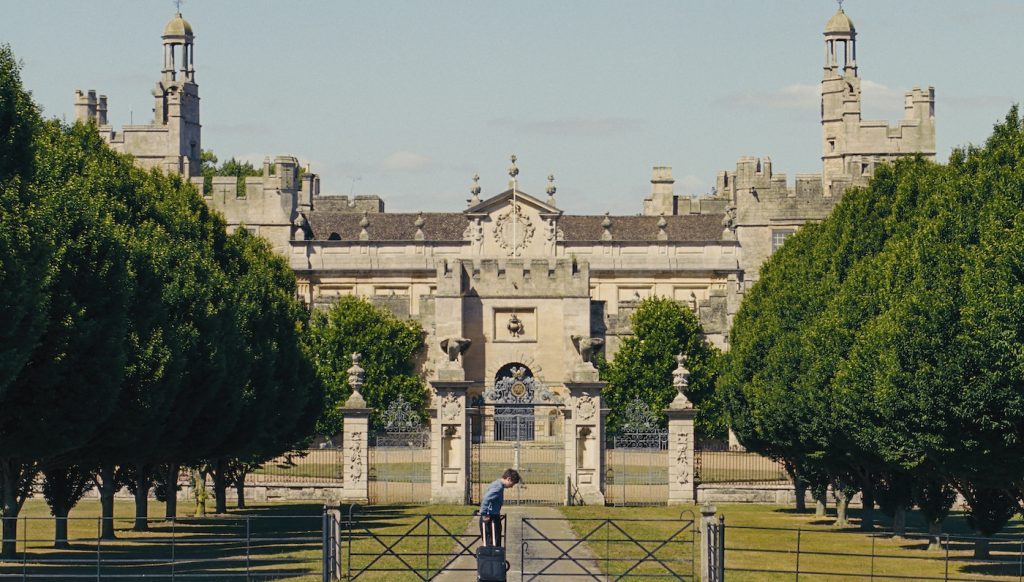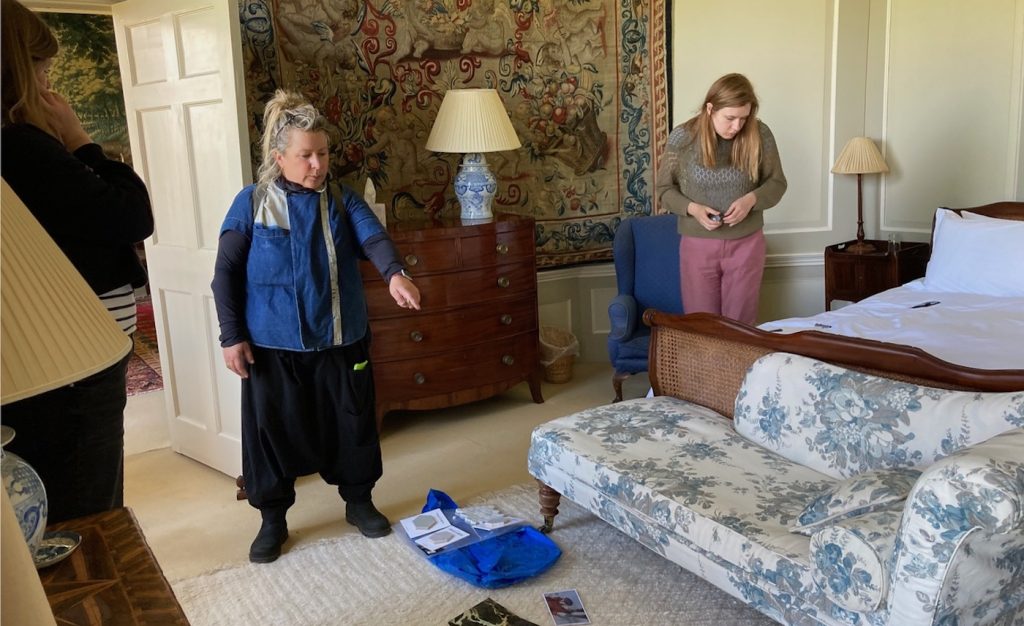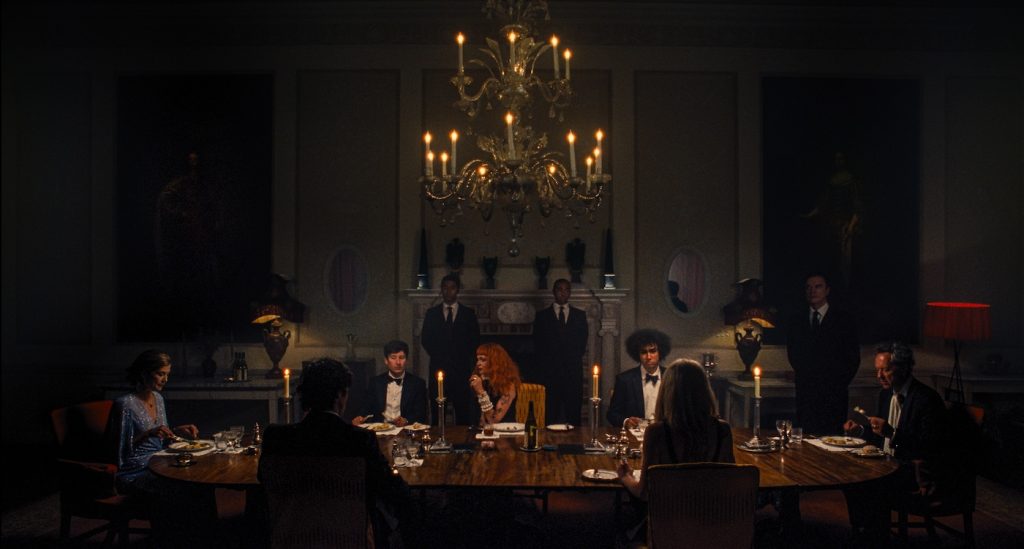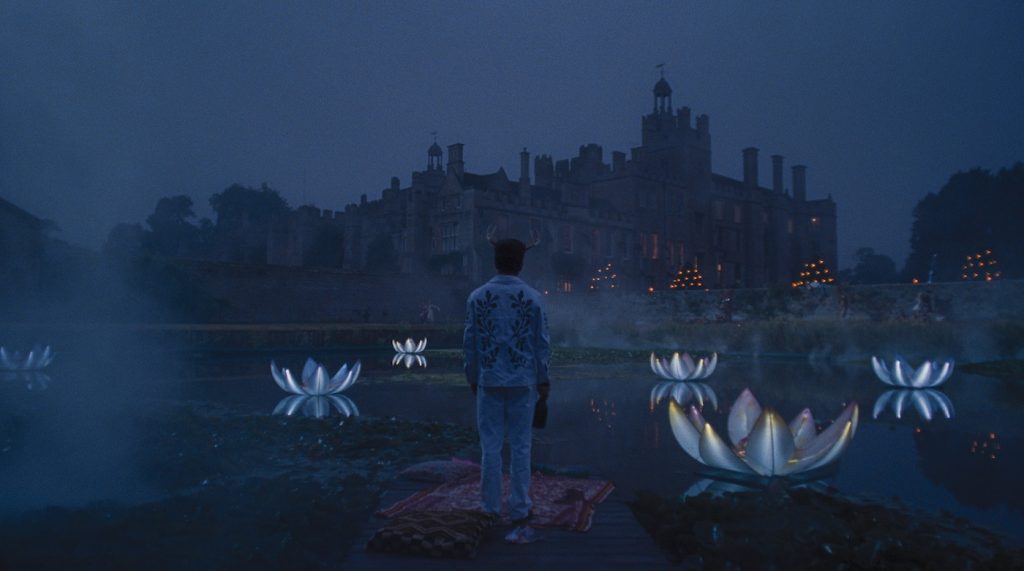How “Saltburn” Production Designer Suzie Davies Imbued a Palatial Estate With Sinister Detailing
Like so many of us, production designer Suzie Davies loved Emerald Fennel’s debut, Promising Young Woman. When she heard that the actress-turned-director planned a sex-drenched thriller called Saltburn as a follow-up to her debut feature, Davies, Oscar-nominated for designing Mike Leigh’s lush period piece Mr. Turner, threw her hat in the ring. “I was like, ‘Let me get in the room with Emerald!'” she says. “My agent got me the script, I put a pitch together, and we got on straight away. Whenever I suggested something, Emerald was like, ‘bigger, bolder.’ Anything even slightly weird, she’d say, ‘Absolutely, that will work!'”
Saltburn (in select theaters now) stars Barry Keoghan, Oscar-nominated for The Banshees of Inisherin, as Oxford University misfit Oliver Quick. Invited by aristocratic classmate Felix Catton (Jacob Elordi of Euphoria and Priscilla) to spend the summer at his family’s palatial estate, Oliver insinuates himself with Felix’s narcissistic mother, father, sister and cousin (played respectively by Rosamund Pike, Richard E. Grant, Alison Oliver and Archie Madekwe) to ruinous effect.
Filmmakers shot Saltburn on location at Oxford University, where Fennel went to school, and at a 200-acre estate in northern England called Drayton House, which dates back to the 1200s and has never before been featured in a movie.
Speaking from her London home, Suzie explains how she reconfigured an ancient castle to serve Fennell’s pitch-black comedy-turned-tragedy of manners.
Oxford University seems posh at the start of the movie, but it’s nothing compared to “Saltburn.” When Felix arrives at the sprawling Catton estate for the summer, he’s dumbstruck by its sheer scale. What was your reaction the first time you saw this place?
Exactly the same as Oliver’s — I was blown away. It’s a beautiful long drive up to this house, this manor, this castle, I can’t even call it a house, and probably a mile long, through the most delicious countryside. We went in the springtime so everything’s green and vivid and lush. You see the house in the distance, and it just gets bigger and bigger and bigger with layers of architecture every which way. Generations of families have lived there since 1066, so everyone’s added their bits — medieval, Georgian, Victorian.

Sounds like the house has a lot of personality.
This estate absolutely was a character, like it was smoking a cigarette and drinking a gin and tonic while leaning back — very confident and relaxed in its environment.
Using this formidable historic structure as a foundation, how much latitude did you have in re-shaping the home for the purposes of this film?
Rather than dealing with National Trust or English Heritage [saying] “Don’t touch anything, don’t paint anything,” this family let me run riot. When we got to the boys’ rooms, they were in the wrong colors and wrong configurations, so the family allowed us to paint the walls this lush, rich, basically red shiny glaze, change the tapestry, put up our own wallpaper, change the floor, rip out a bathroom, put in a dressing room, rip out a bedroom, put in another bathroom. That was really satisfying because you can use the idiosyncrasies of a real location to make something special with composited sets that look out the windows with great views. And this is a house with 127 rooms, so we had a lot to choose from!

Even the wallpaper draws you in.
I’m loving that you noticed the wallpaper because it isn’t just subtext. We did it with intention. For Oliver’s room, we used this brilliant wallpaper, a 1960s print, which you can see in close-up is a maze [pattern]. Felix’s room, we added a tapestry of ancient battle scenes of people slaying dragons. In the bathroom, the wallpaper mimics the muscles on Barry’s back, all sinews and muscle, with lovely marble-like wallpaper in the panels, which sort of looks like oil that’s dripping.
Dripping?
I had this idea that the film, toward the end, should look like an oil painting that’s dripping with the heat of the story.
The home’s vaulted ceilings, rich antique furniture, and million-dollar paintings define luxury, even though the aristocrats who live there seem to take it all for granted.
We added elements to make things even grander, but every time we made it grander, we also put in a slightly subversive element. The ballroom, with the beautiful flowers and the paintings, looks clean within an inch of its life, but there’s a fly strip hanging from the chandelier. Little things like that — the house needed to feel lived in.

The estate’s massive grounds include a maze-shaped garden where Oliver runs around with horns on his head during his wild nighttime masquerade party. Was this maze part of the property when you arrived?
No. The [overhead] top shot was CG, and the maze [on the ground] was designed by this amazing designer, Adrian Fisher. We worked out how our characters would run and then plopped in these hedges so that when you’re in the middle of the maze — that’s all construction. We moved probably twenty meters of real hedges in and out, and because [the big sequence] took place at night, we could make those runs quite short.

At the center of the maze stands this eerie statue of a minotaur, the half-man-half-bull creature of Greek mythology. Did you sculpt the minotaur from scratch?
We found this brilliant artist Nicola Hicks, and she gave us permission to use her artwork as inspiration. From there, we developed our minotaur, which we called Big Willy for obvious reasons. It was sculpted out of polystyrene, which, funny enough, is how I started out in the industry as a polystyrene sculptor. There are four other minotaurs at each point of the maze from our brilliant team of makers in the art department, but I must admit I couldn’t help but get myself in there, covered in paint.
Bad things happen at the party, and the situation goes downhill from there. How did color, especially the color red, figure into your design as a way of intensifying the drama.?
We used every tone — dark red, dried blood red, neon red. At one point, I was going to paint the walls, but there was some ornate plasterwork on the panels in that breakfast room, which would have cost too much time and money to paint around. But it was a bland room, and we wanted to bring more color into the film. Then I noticed the room had an orange-red carpet. “What can we do with this?” Fried eggs were a big part of one sequence, so I started thinking about the white and yellow and the little bit of red you see in a fried egg, and we made these red-striped chair fabrics.
And the curtains?
Massive curtains were a way for me to bring some color in. We got this shot silk fabric…
What’s shot silk?
Raw silk. If you run your hands over shot silk, you feel bumps and lumps, and it’s thicker than the smooth silk you’d wear as a shirt.
So you make enormous shot silk curtains and…
When Emerald came in, the sun was shining through the window, and this orange-red sheer silk curtain looked amazing. She decided this was our chance to go orange-red in the scene where they’re all losing it.
When the curtains are drawn, the entire room takes on this reddish hue, amplifying the characters’ unhinged emotions. It must have been exciting to orchestrate all these tones and details in service of Emerald Fennel’s dark vision?
It’s great when a director uses detail as well as Emerald does. There’s that scene where Oliver pours the wine, and we see wine seeping through the white tablecloth. Or the Pierrot Box, with the little characters dancing.
The spooky marionette theater. Where did you find that?
We made it.
Really!
The Pierrot box is this thing that usually has a little dancing clown in it. We made this box with our little characters dancing but couldn’t quite get the mechanism to work. When Emerald saw it, she liked that it was a bit jolty and a bit mad when they did their little dance. Weird or rude, that’s what Emerald wanted in her storytelling. Weird or rude.
Featured image: Barry Keoghan is Oliver Quick in “Saltburn.” Courtesy of MGM and Amazon Studios.



